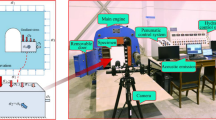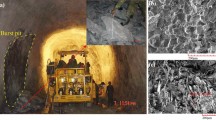Abstract
Rock burst is a typical type of dynamic geological disaster in the process of underground engineering excavation under high in-situ stress. Based on the understanding of the principle of elastic strain energy accumulation and release in the process of rock burst, the uniaxial load rock burst test is carried out using the self-designed rock burst process experiment system. In addition, the simulation of rock burst with different strength levels is realised. The distribution characteristics of rock burst debris, intensity of rock burst, acoustic emission characteristics, failure mode and energy characteristics of rock burst fracture surface were analysed using statistics and effective kinetic energy theory. According to the test results, the whole process of rock burst is divided into three stages: static incubation stage, dynamic burst stage and comprehensive rock burst development stage. A more severe degree of rock burst indicates larger mass proportion of rock burst fragments, more broken rock burst fragments, farther ejection and throwing distance of fragments and greater effective kinetic energy of fragments. The weaker degree of rock burst indicates smaller mass proportion of rock burst fragments, larger mass of damaged blocks, closer ejection and throwing distance of blocks and smaller effective kinetic energy of fragments. In the load process, many tensile cracks and a certain amount of shear cracks are generated. When more cracks are generated in the load process, the acoustic emission activity becomes more intense. The detritus produced are mostly lumpy, flaky and lamellar.Please confirm the corresponding author mail ID is correctly identified and amend if necessary.The mail ID is accurate.



















Similar content being viewed by others
Data Availability
Enquiries about data availability should be directed to the authors.
References
Chen XH, Deng XL, Li ZH (2008) Mechanics analysis on the conditions of rock burst occurrence in the coal mass of roadway rib. J Coal Sci Eng 14(2):213–216
Chen BR, Feng XT, Li QP, Luo RZ, Li SJ (2015) Rock burst intensity classification based on the radiated energy with damage intensity AI Jinping II hydropower station, China. Rock Mech Rock Eng 48:289–303
Diederichs MS, Kaiser PK, Eberhardt E (2004) Damage initiation and propagation in hard rock during tunnelling and the influence of near-face stress rotation. Int J Rock Mech Min Sci 41:785–812
Gao MS, Dou LM, Zhang N (2008) Simulation of the relationship between roadway dynamic destruction and hypocenter parameters. J China Univ Min Technol 18(1):93–97
Gong WL, Peng YY, Wang H, He MC, Sousa RE, Wang J (2015) Fracture angle analysis of rock burst faulting planes based on true-triaxial experiment. Rock Mech Rock Eng 48:1017–1039
Gu ST, Zhang W, Jiang BY, Hu CC (2019) Case of rock burst danger and its prediction and prevention in tunneling and mining period at an irregular coal face. Geotech Geol Eng 37:2545–2564
Guo WJ, Li YY, Yin DW, Zhang SC, Sun XZ (2016) Mechanisms of rock burst in hard and thick upper strata and rock-burst controlling technology. Arab J Geosci 9:561–572
Hamdia KM, Silani M, Zhuang XY, He PF, Rabczuk T (2017) Stochastic analysis of the fracture toughness of polymeric nanoparticle composites using polynomial chaos expansions. Intern J Fract 206(2):217–227
He MC, Sousa LRE, Miranda T, Zhu G (2015) Rockburst laboratory tests database-application of data mining techniques. Eng Geol 185:116–130
He J, Dou LM, Mu ZL, Cao AY, Gong SY (2016) Numerical simulation study on hard-thick roof inducing rock burst in coal mine. J Cent South Univ 23:2314–2320
He MC, Li JY, Ren FQ (2020) Rock burst criterion based on clay mineral content. Arab J Geosci 13:185–193
Huang RQ, Wang XN, Chan LS (2001) Triaxial unloading test of rocks and its implications for rock burst. Bull Eng Geol Environ 60:37–41
Jia CY, Wang HL, Sun XZ, Liu KM, Zhang GB, Yu XB, Song XY (2020) Similar material simulation test of overlying strata characteristics of isolated working face mining with thick-hard strata. Geotech Geol Eng 38:1121–1132
Jiang LS, Kong P, Zhang PP, Shu JM, Wang QB, Chen LJ, Wu QL (2020) Dynamic analysis of the rock burst potential of a Longwall panel intersecting with a fault. Rock Mech Rock Eng 53:1737–1754
Li XL, Wang EY, Li ZH, Liu ZT, Song SZ, Qiu LM (2016) Rock burst monitoring by integrated microseismic and electromagnetic radiation methods. Rock Mech Rock Eng 49:4393–4406
Li TB, Ma CC, Zhu ML, Meng LB, Chen GQ (2017a) Geomechanical types and mechanical analyses of rockbursts. Eng Geol 222:72–83
Li TZ, Li YX, Yang XL (2017b) Rock burst prediction based on genetic algorithms and extreme learning machine. J Cent South Univ 24:2105–2113
Li ZQ, Xue YG, Li SC, Qiu DH, Zhang LW, Zhao Y, Zhou BH (2020) Rock burst risk assessment in deep-buried underground caverns: a novel analysis method. Arab J Geosci 13:388–399
Liu ZB, Shao JF, Xu WY, Meng YD (2013) Prediction of rock burst classification using the technique of cloud models with attribution weight. Nat Hazards 68:549–568
Liu L, Chen ZQ, Wang LG (2015) Rock burst laws in deep mines based on combined model of membership function and dominance-based rough set. J Cent South Univ 22:3591–3597
Liu H, Yu B, Liu JR, Wang TX (2019) Investigation of impact rock burst induced by energy released from hard rock fractures. Arab J Geosci 12:381–393
Lu AH, Mao XB, Liu HS (2008) Physical simulation of rock burst induced by stress waves. J China Univ Min Technol 18:0401–0405
Lu CP, Liu GJ, Liu Y, Zhang N, Xue JH, Zhang L (2015) Microseismic multi-parameter characteristics of rockburst hazard induced by hard roof fall and high stress concentration. Int J Rock Mech Min Sci 76:18–32
Meng XX, Liu WT, Zhang H (2018) A study of rock burst hazard prevention method. Geotech Geol Eng 36:2237–2246
Miao SJ, Cai MF, Guo QF, Huang ZJ (2016) Rock burst prediction based on in-situ stress and energy accumulation theory. Int J Rock Mech Min Sci 83:86–94
Qi G, Wei ZY, Meng H (2014) Numerical and experimental method to determine the boring diameters of a two-stage TBM cutterhead to prevent rock burst. J Mech Sci Technol 28(11):4613–4620
Wang SR, Li CY, Yan WF, Zou ZS, Chen WX (2017) Multiple indicators prediction method of rock burst based on microseismic monitoring technology. Arab J Geosci 10:132–140
Wang XT, Li SC, Xu ZH, Xue YG, Hu J, Li ZQ, Zhang B (2019) An interval fuzzy comprehensive assessment method for rock burst in underground caverns and its engineering application. Bull Eng Geol Environ 78:5161–5176
Wu SC, Wu ZG, Zhang CX (2019) Rock burst prediction probability model based on case analysis. Tunn Undergr Space Technol 93:103069
Xiao YX, Feng XT, Li SJ, Feng GL, Yu Y (2016) Rock mass failure mechanisms during the evolution process of rockbursts in tunnels. Int J Rock Mech Min Sci 83:174–181
Xie LT, Yan P, Lu WB, Chen M, Wang GH (2018) Effects of strain energy adjustment: a case study of rock failure modes during deep tunnel excavation with different methods. KSCE J Civ Eng 22(10):4143–4154
Xu NW, Li TB, Dai F, Li B, Zhu YG, Yang DS (2015) Microseismic monitoring and stability evaluation for the large-scale underground caverns at the Houziyan hydropower station in Southwest China. Eng Geol 188:48–67
Zhang CQ, Feng XT, Zhou H, Qiu SL, Wu WP (2012) Case histories of four extremely intense rockburst in deep tunnels. Rock Mech Rock Eng 45(3):275–288
Zhang ZZ, Gao F, Shang XJ (2014) Rock burst proneness prediction by acoustic emission test during rock deformation. J Cent South Univ 21:373–380
Zhao TB, Guo WY, Tan YL, Yin YC, Cai LS, Pan JF (2018) Case studies of rock bursts under complicated geological conditions during multi-seam mining at a depth of 800 m. Rock Mech Rock Eng 51:1539–1564
Zhao Y, Bi J, Zhou XP (2020) Quantitative analysis of rockburst in the surrounding rock masses around deep tunnels. Eng Geol 273:105669
Zhou XP, Zhang XQ (2017) The 3D numerical simulation of damage localization of rocks using general particle dynamics. Eng Geol 224:29–42
Zhu WS, Zhang QB, Zhu HH, Li Y, Yin JH, Li SC, Sun LF, Zhang L (2010) Large-scale geomechanical model test study of an underground cavern group under true three-dimensional stress state. Can Geotech J 47(9):935–946
Acknowledgements
This research was funded by the China Postdoctoral Science Foundation (No. 2017M623388). We are grateful to anonymous reviewers for their constructive reviews on the manuscript, and the editors for carefully revising the manuscript.
Author information
Authors and Affiliations
Corresponding author
Ethics declarations
Conflict of interest
The authors have not disclosed any competing interests.
Additional information
Publisher's Note
Springer Nature remains neutral with regard to jurisdictional claims in published maps and institutional affiliations.
Rights and permissions
About this article
Cite this article
Fan, J., Guo, P., Kong, F. et al. Experimental Study on Rock Failure Characteristics of Ejective Rock Burst Based on Energy Compensation. Geotech Geol Eng 40, 5547–5564 (2022). https://doi.org/10.1007/s10706-022-02232-4
Received:
Accepted:
Published:
Issue Date:
DOI: https://doi.org/10.1007/s10706-022-02232-4




